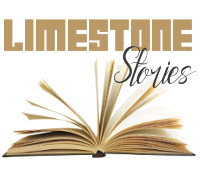- Why Mining Matters
- Jobs
- Safety
- Environment & Operations
- FAQ
- Links
- Fun Stuff
You are here
Eastern Lime Company
We love examples of former mines and quarries that operated in what are now the middle of towns!
The Eastern Lime Company operated two limestone quarries in Windsor, Hants County, on the east bank of the Avon River, just southwest of the Haliburton House Museum property. The area is a lovely residential neighbourhood today.
According to a 1934 report, limestone had been extracted from the site “since the district was first settled” to make lime for use in cement and for agricultural lime. Lime is produced by crushing limestone down to powder and calcining it. (Calcining means heating a mineral to the point of changing its mineral structure. It is done as part of the process of manufacturing minerals into products. Calcining limestone removes carbon dioxide and leaves behind lime.) Lime is an ingredient in cement, and it is spread on farm fields to improve soil quality.
We could not grow enough food to feed earth’s population without fertilizers and other tools made by possible by mining.
Limestone quarried by the Eastern Lime Company was used to manufacture quicklime, hydrated lime, agricultural lime and used in roadbuilding.
The company worked two quarries, the North and South.
The North quarry was an open pit 175 feet in diameter and 40 feet deep, at the time of the 1934 report. The quarry floor had a fissure – a naturally occurring long, narrow opening – that was 42 feet deep. The fissure had 16 feet of water in it in 1934, but its walls were of the same limestone that was being quarried, so the limestone deposit extended at least another 26 feet below the quarry’s floor. This, combined with the fact that test pits (holes dug to see what type of bedrock was underground) found that limestone underlay the eight-acre property and likely extended further, meant the limestone deposit was a significant size. A 1932 federal Department of Mines memo suggested the deposit had “apparently in excess of 900,000 tons available above high-water level and possibly a like amount beneath this level.”
The South quarry was 800 feet southwest of the North quarry and quarried into the side of a hill. It had a working face 15-20 feet high and 150 feet long. Stone had been extracted to a depth of 80 feet into the bottom of the hill.
Quarrying was done using air drills to drill holes into the rock. Dynamite was then inserted into the holes to blast the stone free of the working faces.
At both quarries, the rock was loaded by hand into small cars which were pulled up inclined tracks by electric hoists.
All stone from the North quarry was taken to the agricultural lime plant located immediately next to the quarry, where it was pulverized in a mill that could pulverize three tons of rock per hour.
An asphalt filler plant was also near the North quarry. It processed pulverized limestone provided by the agricultural lime plant.
The South quarry’s stone was made into lime for other purposes. Its plant was at the South quarry and had a kiln with a capacity of nine tons of lime per 24 hours. It also had a hydrator and air separator.
The company’s products were shipped from a siding on the Dominion Atlantic railway, which was connected to the agricultural lime plant by a narrow-gauge tramway 1,700 feet long.
The Eastern Lime Company was owned by Herbert Charles Burchell, who was born in Sydney, Cape Breton, in 1855. Burchell was Assistant Engineer to Nova Scotia’s Provincial Engineer from 1875-78. He joined the public service in Newfoundland and spent from the 1880s to early 1900s there, eventually serving as Deputy Minister and Chief Engineer of the Public Works department. He was also a St. John’s municipal councillor from 1898-1905. He returned to Sydney in 1906 and ran the Sydney Cement Company. He later moved to Windsor.
About 1000 feet from the Eastern Lime Company’s property was the Clifton gypsum quarry, on the property of the Haliburton House Museum. It is a lake and residential neighbourhood today. See its story at https://notyourgrandfathersmining.ca/clifton-quarry


















































































